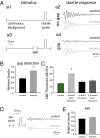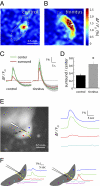Mice with behavioral evidence of tinnitus exhibit dorsal cochlear nucleus hyperactivity because of decreased GABAergic inhibition
- PMID: 21502491
- PMCID: PMC3088638
- DOI: 10.1073/pnas.1100223108
Mice with behavioral evidence of tinnitus exhibit dorsal cochlear nucleus hyperactivity because of decreased GABAergic inhibition
Abstract
Tinnitus has been associated with increased spontaneous and evoked activity, increased neural synchrony, and reorganization of tonotopic maps of auditory nuclei. However, the neurotransmitter systems mediating these changes are poorly understood. Here, we developed an in vitro assay that allows us to evaluate the roles of excitation and inhibition in determining the neural correlates of tinnitus. To measure the magnitude and spatial spread of evoked circuit activity, we used flavoprotein autofluorescence (FA) imaging, a metabolic indicator of neuronal activity. We measured FA responses after electrical stimulation of glutamatergic axons in slices containing the dorsal cochlear nucleus, an auditory brainstem nucleus hypothesized to be crucial in the triggering and modulation of tinnitus. FA imaging in dorsal cochlear nucleus brain slices from mice with behavioral evidence of tinnitus (tinnitus mice) revealed enhanced evoked FA response at the site of stimulation and enhanced spatial propagation of FA response to surrounding sites. Blockers of GABAergic inhibition enhanced FA response to a greater extent in control mice than in tinnitus mice. Blockers of excitation decreased FA response to a similar extent in tinnitus and control mice. These findings indicate that auditory circuits in mice with behavioral evidence of tinnitus respond to stimuli in a more robust and spatially distributed manner because of a decrease in GABAergic inhibition.
Conflict of interest statement
The authors declare no conflict of interest.
Figures





References
-
- Jastreboff PJ, Brennan JF, Coleman JK, Sasaki CT. Phantom auditory sensation in rats: An animal model for tinnitus. Behav Neurosci. 1988;102:811–822. - PubMed
-
- Bauer CA, Brozoski TJ, Rojas R, Boley J, Wyder M. Behavioral model of chronic tinnitus in rats. Otolaryngol Head Neck Surg. 1999;121:457–462. - PubMed
-
- Heffner HE, Harrington IA. Tinnitus in hamsters following exposure to intense sound. Hear Res. 2002;170:83–95. - PubMed
Publication types
MeSH terms
Substances
Grants and funding
LinkOut - more resources
Full Text Sources
Medical
Molecular Biology Databases

